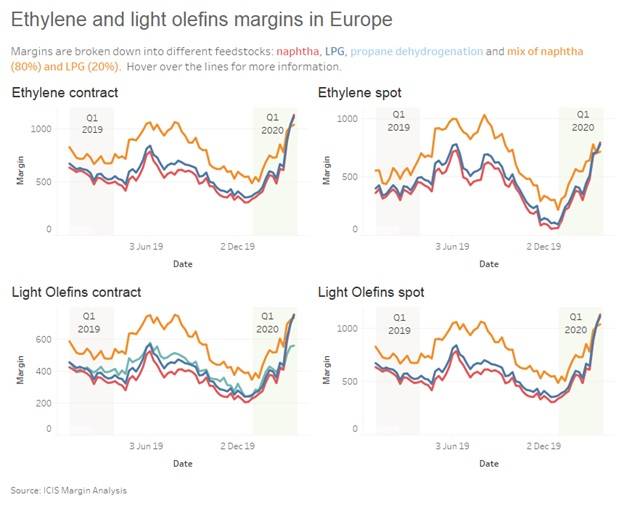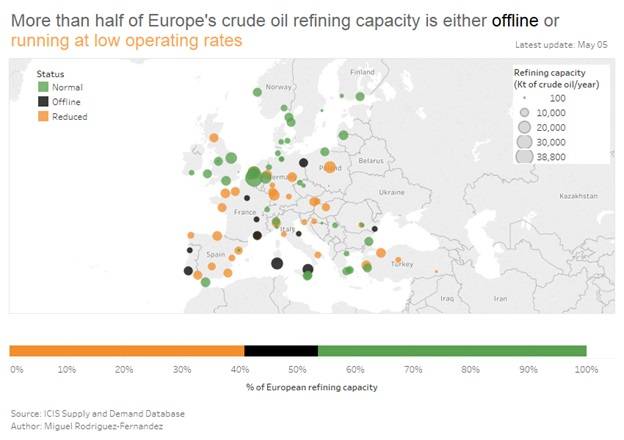More Disruption and Uncertainty in Store for Petrochemicals
The impact of the coronavirus lockdowns on the oil, gas and chemicals industries’ integrated value chains is radically shifting relationships and profitability.
It is also making planning virtually impossible, as BASF suggested last week.
The environment around refining and chemical margins remains challenging, Shell CEO Ben van Beurden also said this week.
“The key to the profitability of our chemicals plants and refineries is their integrated value chain from their feedstocks to the multiple products they produce,” he said.
“The demand volatility of a particular product can have a broader impact on the operational capability of the integrated value chain. For example, a reduction in the demand for jet fuel at a refinery can impact the viability of the entire refinery. Looking ahead, we expect significant price and margin volatility in the short to medium term.”
Companies are also confronted by recessionary trends in the markets and in the countries in which they operate.
“This volatility presents a unique challenge for oil and gas producers, with the need to balance the requirement for cash today, with appropriate investment across the portfolio to generate cash tomorrow,” van Beurden said.
Shell’s steep cut in its dividend made headline news on Thursday.
Oil, gas and chemicals companies are seeking to preserve cash in extraordinarily difficult times while maintaining a level of business that serves them and their customers best.
Upholding operations in these multiple value chains is key. But we are seeing refinery run downs and closures alongside the squeeze on chemical plant operating rates.
Operators of Europe’s crackers and the plants downstream from them are working on shifting sands.
ICIS analysis, updated from only a few weeks ago, looks at the European cracker output under threat from reduced refined products demand, for instance.
The estimate now is that, potentially 37% of the region’s propylene capacity is impacted, 37% of benzene, and 31% of ethylene.
This is apart from the pressure put on production of these vitally important chemical feedstocks from generally weakened downstream demand.
BASF has shuttered facilities serving markets closely related to automobile production. Across the group, its plants are operating at more than 60%, management said.
Dow on Thursday said it is idling five polyethylene (PE)/elastomers facilities in the Americas for at least one month, and it is running reduced global propylene oxide (PO) and methylene diphenyl diisocyanate (MDI) rates until industrial demand improves.
It is running its siloxanes production at reduced rates globally.
ExxonMobil said on Friday that volumes at its chemicals division were down in the first quarter for its non-US chemicals operations while margins for the segment were lower in the quarter, year on year.
US chemicals operations were constrained by overcapacity and the volumes from newly installed US Gulf Coast plants, but margins had remained firm because of cheaper quarter to quarter feedstock costs.
LyondellBasell said that its olefins and polyolefins segments – in the Americas and Europe/rest of the world – had experienced consumer-driven demand for polymers used in packaging and medical products but that the impact of the pandemic and low crude oil prices would continue to impact its businesses in the second quarter
“Weak demand from markets for industrial and durable products is expected to persist,” it said.

Producers are seeing improved liquid cracker margins in Europe and in northeast Asia while the ethane feedstock advantage persists in the US and the Middle East.
What is gained in terms of margin at the cracker, however, does have to be translated into profits downstream, whether a company is integrated or not.
There is increased tension between integrated and non-integrated players now in important contract price negotiations across the board in chemicals.
For the latest reporting period, some of the big petrochemical producers have acknowledged the gains they made towards the end of the quarter from lower crude oil derived feedstock costs.The data show the considerable gains made by naphtha cracker operators per tonne of product sold, as long as they are able to translate the gains on the monomers either into profits directly or into integrated downstream businesses.
At the moment, those lower costs are working their way down through various petrochemical and plastics production chains, prompting steeply reduced product prices.
Inventory holding losses also played a significant part in reducing reported profitability for petrochemical producers in Q1.
The dynamic of these cost and price movements will play out particularly noticeably in the second quarter.
European ethylene and propylene contract prices for May fell for the third consecutive month; watch this video by ICIS Senior Editor Nel Weddle to find out more.
April was an extremely difficult month for the chemical and plastics industry in Europe and elsewhere.
May brings with it even more disruption and uncertainty.


